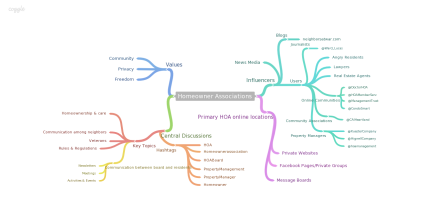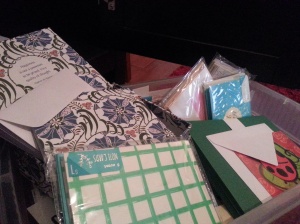I have always been a perfectionist.
Failing has always been one of my greatest fears.
I am my own worst critic.
I’m 32 years old, and these are my truths. Thankfully, these truths don’t always hold me back. Since beginning graduate school, and especially this Creativity and Networks class, I have learned that part of my process is allowing myself to panic, to be fearful of the unknown. Once I allow my lizard brain (Godin, 2012) to have a go at talking me out of something, I am set to create something. I require a lot of relaxed attention (Kelley & Kelley, 2013) and productive procrastinating (Kleon, 2012; Kleon, 2014).
I am already becoming more creatively confident (Kelley & Kelley, 2013). Today I am a painter, a poet, a sculptor, a crafter, a designer, a baker, and a cook. I am a problem-solver, a question-asker, a change-maker, and a people-mover. Those embody my art today, and maybe I’ll have more art tomorrow. I have learned that art isn’t always something you hang on the wall or display on a shelf. Art can happen at home, at work, outside, or inside. It’s the way you share your strengths, strengthen your weaknesses, and make connections with other humans.
Without question, the most fun creativity project was the trash art for which I made an interior hanging wreath. While I know part of the creative process is to jump out of your comfort zone, found object art is something with which I have always been comfortable. I like collecting random bits of flotsam and jetsam, unseeing their original purpose, and mashing them together to make something new. Seth Godin (2012) tells us to “learn to see… see the world as it is, without labels, without knowing the name of what is seen” (p. 144). He goes on to say, “Art is the act of pointing a light at the darkness” (p. 149). These thoughts are helpful in trash art. First, it was an engine seal. Then, it had no name; it was merely a piece of junk with great potential. Finally, after shining a light, after playing with it along with the other bits, it became the base of a beautiful wreath.
The most challenging activity was creating the short video. Knowing that we were limited to 30 seconds or less to tell a story nearly paralyzed my creativity. Unlike ad agencies, I did not have the luxury of a crew, so I had to develop the concept, write the script, set the scene, adjust the lighting, narrate, and operate the camera. Knowing all of this from the beginning, it took me much longer than I expected to create a product, and it was only after skimming quotes about being neighborly that I felt inspired to create. Then finding a way to tuck it into a seconds-long video? Yikes. I know now that I can’t always be good at something I’ve never done before, so I have to just put it out there. If I want to make better videos, I will have to make more videos.
In Week 1 of the course, I responded yes to whether or not I consider myself a creative person. This has not changed, even with the challenge of the video, or the ramble, or writing my own newspaper blackout poem, though I realize now the breadth, depth, and potential of my creativity. I often try to compartmentalize how I will be creative, in what contexts, for what audiences, but I’m recognizing that my creativity extends much farther than I ever thought, and it can extend farther still. Even though many of my colleagues already consider me creative, I’m feeling empowered now to find new ways to really knock their socks off.
Moving into the future, there are three major points I need to remember about building, maintaining, and showcasing my creative competence. First, I must make a habit of enjoying the process of art, not just the product. I already do this with the found object/trash art, so I should be able to apply it to other creative situations. Austin Kleon (2014) tells us that we don’t have to operate as tortured artists, that the process is messy but it’s okay to share some of the messy parts because it builds connections. I think this boils down to not being in control all the time. Second, I need to think about Kelley and Kelley’s (2013) advice to empathize with the end user more when making my art, especially at work. With my art at home, I’m usually doing something for only me. But, for my art to mean anything to anyone else or make any difference, I have to better understand the needs of the users (not just customers, but also my bosses). Third, taking risks is encouraged and failing is okay. For me, this will always be the hardest to apply though it will be the most frequently repeated. Perfect is impossible and boring, and learning is not possible without failure. Godin (2012) says, “The future is unknowable, and if you are betting everything on the unknowable’s being in perfect connection with your idea, you will likely make nothing much” (p. 159), “Failure is an event, not a person” (p.187), and “Whatever happens, things are going to be fine in the end, that the pain is part of the journey, and that without pain there really isn’t a journey worth going on” (p. 214). Sometimes, I will just have to go for it, not expecting any particular outcome, and no matter what happens, I will be okay.
This semester’s readings have made a very strong case regarding the creative, innovative, connection economy. It looks like we are moving out of the industrial age and away from a black/white, right/wrong, quantitative culture. My dad, a market researcher, tells me that his clients still rely on data, big data; in fact, they are ravenous for it. He has to explain to them that data doesn’t mean anything without connecting it to people; he has to make them understand that big data without meaning or a plan of action is worthless. Ben Waber (2013) points out that “people analytics” is the next revolutionary shift in big data because human behavior is more meaningful than survey responses. Even with our increased dependence on our electronic devices, he says, “Because most communication and collaboration happens face to face, the data are critical for people analytics to take that next leap forward and become a transformative organizational tool. By combining precise data from both real and virtual worlds, we can understand behavior at a previously unimaginable scale” (para. 4). Like Waber, Penenberg (2010) highlights the importance and significance of human behavior in the virtual world. That said, I’m afraid that consumers are still just targets and demographics to big corporations. I am somewhat encouraged by Mashable’s (2013) article about marketers who are responding to human behavior, not just revenue. Godin (2012) says, “Artists want to add energy to the system, to shake it up, to keep the game moving forward” (p. 207). Are these marketers artists because they are not just sucking energy from the system or increasing market share? Sure they want their companies to be profitable, but aren’t they, too, moving the game forward?
Of all that I have learned this semester, I think one of the most important is to remember that we are all human, and we thrive on making connections. We want our ideas to matter. We want to have direction and purpose. We should respect others and seek to understand. And, as Seth Godin says over and over, make art – because you must, because you can, and because there’s never been a better time to do it.
References
Godin, S. (2012). The Icarus deception: How high will you fly? New York, NY: Portfolio/Penguin.
Kelley, T., & Kelley, D. (2013). Creative confidence: Unleashing the creative potential in us all. New York, NY: Crown Business.
Kleon, A. (2014). Show your work: 10 ways to show your creativity and get discovered. New York, NY: Workman.
Kleon, A. (2012). Steal like an artist: 10 things nobody told you about being creative. New York, NY: Workman Publishing.
Mashable. (2013). Eight marketers doing big data right.
Penenberg, A. (2010). How video games are infiltrating–and improving–every part of our lives. Fast Company.
Waber, B. (2013). The next big thing in big data: People analytics. Business Week.












